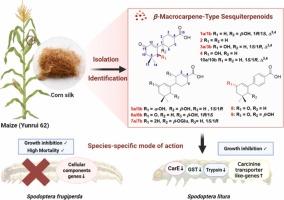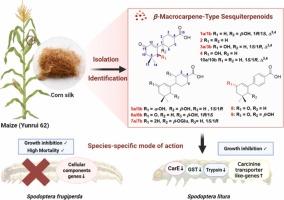Novel β-macrocarpene sesquiterpenoids from maize with inhibition potential against Spodoptera pests via species-specific mechanisms
IF 6.2
1区 农林科学
Q1 AGRICULTURAL ENGINEERING
引用次数: 0
Abstract
Phytochemical profiling of maize silk (Yunrui 62) revealed nine novel β-macrocarpene-type sesquiterpenoids (1–9) and the known analog 10, with structures established through integrated NMR, HRESIMS, X-crystallographic, and ECD analyses. Bioassays demonstrated potent anti-insect activity: compounds 2, 3, 6, 7, and 10 significantly suppressed Spodoptera frugiperda larval weight gain, whereas 4 and 10 inhibited S. litura growth at 20 μg/g in artificial diets. Quantitative analysis showed that compound 10 was broadly distributed across various maize tissues. Furthermore, 10 exhibited dose-dependent efficacies against both pests, inducing rapid S. frugiperda mortality by day 3 at 10 μg/g—exceeding azadirachtin’s potency—while maintaining comparable growth inhibition. Mechanistic studies revealed species-specific modes of action: in S. litura, 10 suppressed the expression of detoxification enzymes and digestive trypsin while upregulating the expression of carcinine transporter-like genes; conversely, in S. frugiperda, the genes encoding midgut cellular components were downregulated without impairing detoxification pathways. Our study provides both the molecular blueprints and a direct strategy for enhancing maize resistance through biosynthetic engineering, paving the way for developing next-generation insect-resistant crops.


从玉米中提取的新型β-大木匠倍半萜类化合物,具有通过种特异性机制抑制夜蛾害虫的潜力
玉米丝(Yunrui 62)的植物化学分析揭示了9个新的β-macrocarpene型倍半萜类化合物(1-9)和已知的类似物10,通过核磁共振、hresms、x -晶体学和ECD分析建立了它们的结构。生物测定表明,化合物2、3、6、7和10具有较强的抗虫活性,能显著抑制夜蛾幼虫增重,而化合物4和10在人工饲料中浓度为20 μg时,能抑制斜纹夜蛾的生长。定量分析表明,化合物10广泛分布于玉米各组织中。此外,其中10种对这两种害虫表现出剂量依赖性的效果,在10 μg/g的浓度下,在第3天诱导frugiperda快速死亡-超过印楝素的效力-同时保持相当的生长抑制作用。机制研究揭示了物种特异性的作用模式:在斜纹山梨中,10抑制解毒酶和消化胰蛋白酶的表达,同时上调致癌转运蛋白样基因的表达;相反,在S. frugiperda中,编码中肠细胞成分的基因被下调,但不损害解毒途径。我们的研究提供了通过生物合成工程增强玉米抗性的分子蓝图和直接策略,为开发下一代抗虫作物铺平了道路。
本文章由计算机程序翻译,如有差异,请以英文原文为准。
求助全文
约1分钟内获得全文
求助全文
来源期刊

Industrial Crops and Products
农林科学-农业工程
CiteScore
9.50
自引率
8.50%
发文量
1518
审稿时长
43 days
期刊介绍:
Industrial Crops and Products is an International Journal publishing academic and industrial research on industrial (defined as non-food/non-feed) crops and products. Papers concern both crop-oriented and bio-based materials from crops-oriented research, and should be of interest to an international audience, hypothesis driven, and where comparisons are made statistics performed.
 求助内容:
求助内容: 应助结果提醒方式:
应助结果提醒方式:


